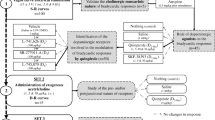Summary
This study describes a component of 5-HT-evoked depolarization of the rat isolated vagus nerve which was unaffected by the 5-HT3 receptor antagonist ondansetron. A grease-gap extracellular recording technique was used. Ondansetron (10–100 nmol/1) displaced the 5-HT concentration-response curve to the right yielding a pA2 value of 8.6 (8.5–8.8), consistent with 5-HT3 receptor antagonism, and revealing a component of the 5-HT response which was resistant to ondansetron blockade. In the presence of ondansetron (100 nmol/1) the maximum depolarization in the resistant phase was 15.5 (12.6–19.2)% of the initial maximum response to 5-HT and the pEC50 value was 7.0 (6.7–7.3). The mechanism of the ondansetron-resistant component of the 5-HT response resembled a 5-HT4 -receptor-effect in being absent in preparations equilibrated with 5-methoxytryptamine (10 μmol/1) and antagonised by ICS 205930 (tropisetron, pA2 6.4). 5-Methoxytryptamine alone was an agonist in the vagus nerve with a maximum response similar to that of the ondansetron resistant phase of the 5-HT response. similarly renzapride alone evoked small depolarizations of this preparation but antagonized the ondansetron resistant phase of the 5-HT response (pA2 7.3–7.4). These effects of 5-methoxytryptamine and renzapride are also consistent with a 5-HT4 receptor mechanism. Ketanserin (1 μmol/1) and methysergide (1 μmol/1) had little effect on responses to 5-HT. The depolarization evoked by this putative 5-HT4 receptor mechanism was small but prolonged and appears to mask and after-hyperpolarizing phase of the 5-HT response in this tissue.
Similar content being viewed by others
References
Andrade R, Chaput Y (1991) 5-Hydroxytryptamine4-like receptors mediate the slow excitatory response to serotonin in the rat hippocampus. J Pharmacol Exp Ther 257:930–937
Arunlakshana O, Schild HO (1959) Some quantitative uses of drug antagonists. Br J Pharmacol Chemother 14:48–58
Azami J, Fozard JR, Round AA, Wallis DI (1985) The depolarizing action of 5-hydroxytryptamine on rabbit vagal primary afferent and sympathetic neurones and its selective blockade by MDL 72222. Naunyn-Schmiedeberg's Arch Pharmacol 328:423–429
Baxter GS, Craig DA, Clarke DE (1991) 5-Hydroxytryptamine4 receptors mediate relaxation of the rat oesophageal and tunica muscularis mucosae. Naunyn-Schmiedeberg's Arch Pharmacol 343:439–446
Bhandari P, Andrews PLR (1991) Preliminary evidence for the involvement of the putative 5-HT4 receptor in zacopride- and copper sulphate-induced vomiting in the ferret. Eur J Pharmacol 204:273–280
Bockaert J, Fagni L, Sebben M, Dumuis A (1991). Pharmacological characterization of brain 5-HT4 receptors: relationship between the effects of indole, benzamide and azabicycloalkylbenzimidazolone derivatives. In: Fozard JR, Saxena PR (eds) Serotonin: molecular biology, receptors and functional effects. Birkhäuser, Basel, pp 220–231
Brown DA, Brownstein MJ, Scholfield CN (1972) Origin of the after-hyperpolarization that follows removal of depolarizing agents from the isolated superior cervical ganglion of the rat. Br J Pharmacol 44:651–671
Buchheit KH, Engel G, Mutschler E, Richardson B (1985) Study of the contractile effect of 5-hydroxytryptamine (5-HT) in the longitudinal muscle-strip from guinea-pig ileum. Naunyn-Schmiedeberg's Arch Pharmacol 329:36–41
Butler A, Hill JM, Ireland SJ, Jordan CC, Tyers MB (1988) Pharmacological properties of GR 38032F, a novel antagonist at 5-HT3 receptors. Br J Pharmacol 94:397–412
Colino A, Halliwell JV (1987) Differential modulation of three separate K-conductances in hippocampal CA1 neurones by serotonin. Nature 328:73–77
Costall B, Coughlan J, Kelly ME, Naylor RJ, Tyers MB (1989) Scopolamine-induced deficits in a T-maze reinforced alteration task are attenuated by 5-HT3 receptor antagonists. Br J Pharmacol 98:636P
Craig DA, Clarke DE (1990) Pharmacological characterization of a neuronal receptor for 5-hydroxytryptamine in guinea-pig ileum with properties similar to the 5-hydroxytryptamine4 receptor. J Pharmacol Exp Ther 252:1378–1386
Craig DA, Eglen RM, Walsh LKM, Perkins LA, Whiting RL, Clarke DE (1990) 5-Methoxytryptamine and 2-methyl-5-hydroxytrypt-amine-induced desensitization as a descriminative tool for the 5-HT3 and putative 5-HT4 receptors in guinea-pig ileum. Naunyn-Schmiedeberg's Arch Pharmacol 342:9–16
DeLean A, Munson PJ, Rodbard D (1978) Simultaneous analysis of sigmoidal curves: application to bioassay, radioligand assay and physiological dose-response curves. Am J Physiol 235:E97–102
Dumuis A, Sebben M, Bockaert J (1989) The gastrointestinal prokinetic benzamide derivatives are agonists at the non-classical 5-HT receptor (5-HT4) positively coupled to adenylate cyclase in neurones. Naunyn-Schmiedeberg's Arch Pharmacol 340:403–410
Fozard JR (1985) 5-Methoxytryptamine discriminates between excitatory neuronal 5-hydroxytryptamine receptors in the guinea-pig ileum. J Pharmacologie 16:498
Ireland SJ (1987). Origin of 5-hydroxytryptamine-induced hyperpolarization of the rat superior cervical ganglion and vagus nerve. Br J Pharmacol 92:407–416
Ireland SJ, Tyers MB (1987) Pharmacological characterization of 5-hydroxytryptamine-induced depolarization of the rat isolated vagus nerve. Br J Pharmacol 90:229–238
Jones BJ, Costall B, Domeney AM, Kelly ME, Naylor RJ, Oakley NR, Tyers MB (1988) The potential anxiolytic activity of GR 38032F, a 5-HT3 receptor antagonist. Br J Pharmacol 93:985–993
Kaumann AJ (1990) Piglet sinoatrial 5-HT receptors resemble human atrial 5-HT4 -like receptors. Naunyn-Schmiedeberg's Arch Pharmacol 342:619–622
Marsh SJ, Stansfield CE, Brown DA, Davey R, McCarthy D (1987) The mechanism of action of capsaicin on sensory C-type neurons and their axons in-vitro. Neuroscience 23:275–289
Mawe GM, Branchek TA, Gershon MD (1986) Peripheral neural serotonin receptors: Identification and characterization with specific antagonists and agonists. Proc Natl Acad Sci USA 83:9799–9803
Newberry NR, Gilbert MJ (1989) 5-hydroxytryptamine evokes three distinct responses on the rat superior cervical ganglion. Eur J Pharmacol 162:197–205
Rhodes KF, Coleman J (1991) A component of 5-HT evoked depolarization of the rat vagus nerve in-vitro is 5-HT4 mediated. In: Proceedings of the Serotonin 1991 Symposium, Birmingham, UK, p 52
Sanger GJ (1987) Increased gut cholinergic activity and antagonism of 5-hydroxytryptamine M-receptors by BRL 24924: potential clinical importance of BRL 24924. Br J Pharmacol 91:77–87
Schoeffter P, Hoyer D (1990) 5-Hydroxytryptamine (5-HT)-induced endothelium dependent relaxation of pig coronary arteries is mediated by 5-HT receptors similar to the 5-HT1D receptor subtype J Pharmocal Exp Ther 252:387–395
Author information
Authors and Affiliations
Additional information
Correspondence to: K. F. Rhodes at the above address
Rights and permissions
About this article
Cite this article
Rhodes, K.F., Coleman, J. & Lattimer, N. A component of 5-HT-evoked depolarization of the rat isolated vagus nerve is mediated by a putative 5-HT4 receptor. Naunyn-Schmiedeberg's Arch Pharmacol 346, 496–503 (1992). https://doi.org/10.1007/BF00169003
Received:
Accepted:
Issue Date:
DOI: https://doi.org/10.1007/BF00169003




